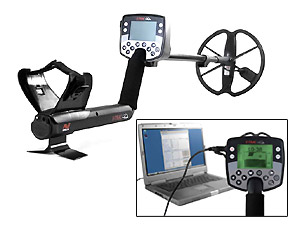Minelab E-Trac - a Metal Detector I Used for Three Years
In Its Time, It Was a Great Machine for Cache Hunting, Relic Hunting and Coin Shooting -
My Short Review and Tips for Beginners
by Sergei UpstateNY, proficiency level: Beginner, last time modified:
During my 16th metal detecting season, I acquired a Minelab E-Trac which then became my primary metal detector for Cache Hunting, Coin Shooting and Relic Hunting.

Because of the E-Trac's improved FBS technology combining the Minelab's multiple frequency BBS (Broad Band Spectrum) with a new powerful microprocessor, the E-Trac would provide greater operating depth range, higher sensitivity over a wide range of targets, less interference from electromagnetic sources and more accurate target identification than its predecessors - Minelab Explorers.
Even though a new technology by XP Metal Detectors was already taking its leading position on the market, I had a few reasons to continue using the Minelab FBS metal detectors; a major reason being my status as a die-hard fan of the Minelab machines. Plus, despite loosing to the XP's breaking-through technology, the Minelab technologies still allowed for finding a satisfactory amount of good targets partially masked by the rusted iron nails at the 'searched-out' sites. So within the 3-year time period, I managed to make many valuable finds with this machine while detecting alongside with the Deus users.
Were Recovered with Minelab E-Trac
When I tried the Minelab E-Trac for the first time, I immediately noticed a big difference between its performance and the Explorer's performance at the same hunt sites. The E-Trac's abilities impressed me. When I tested the E-Trac at the spot which I had "pounded to the last signal" with the Explorer II just the day before, I unearthed a few more medieval coins! You can read all details in my full E-Trac Field-Test Report
Yes, the E-Trac enabled me to find more coins and non-ferrous artifacts at various hunt sites that had been previously thought as expended. But, at the end of my second season with the E-Trac, I noticed that the E-Trac began approaching its technological limits and sometimes was unable to cope with new metal detecting reality. And this reality was generally indicated by depletion of unmasked desirable targets at most hunt sites. Only an advanced detector with a high target-separation ability could bring a substantial results at the 'hunted out' sites. Unfortunately the E-Trac did not have such an ability.
The E-Trac was still superior to the intermediate-level detectors including the Tesoro Cortes (reviewed in this section) which my girlfriend Irina used when we began treasure hunting together. And she did not like having a lot less finds than I at the end of every metal detecting day. So we got her a brand new XP GoldMaxx Power - a detector of the intermediate+ level. After she began beating me in number of finds (mostly the thin-sectioned, tiny hammered silver coins) every time we detected together, I realized that it was a wake-up call for me - I had to admit the presence of a better technology on the market and do something about it.
By that time, the XP Deus had become a reputable machine of an expert level. It certainly attracted my attention, and my first step was to see the advanced XP Deus 'in person' and test it side by side with my E-Trac in the field. One fellow-detectorist had already had the Deus for some time and agreed to show me its capabilities. To prepare a 'test strip' for the Deus, I marked a 3m x 10m strip on the ground in a farm field - a site of a former medieval settlement, that had been previously harrowed, and used the E-Trac to clear the strip of all good signals and even all 'hints' to the good signals.
After we ran the 'comparative test', I was in shock. While the XP Deus picked up a few valuable targets, my E-Trac could not detect or recognize them being masked by nails and other iron objects with which the test strip was infested just like any other area in that farm field. This was how the E-Trac's limitations were discovered. Most likely they were caused by the E-Trac's low Recovery Speed, insufficient maneuverability and dependence of the Operating Detecting Range on the constantly changing Semi-Auto Sensitivity. In fact, this function could considerably reduce the E-Trac's detection depth, and I would not even know about it. And if you switch to the Manual Sensitivity, you must have your ears trained to hear 'questionable' responses to valuable non-ferrous targets. Otherwise, while being overwhelmed by numerous signals produced by ground mineralization, iron falsing, partially masked targets and hot rocks, you would not be able to tell 'good' signals from 'bad' ones.
The Minelab FBS detectors began loosing their superiority to other brands also due to their discommoding design and lack of ergonomics. Heavy weight, poor balance and flaws in construction were major drawbacks of the FBS line's first model - Minelab Explorer XS (also reviewed in this section), and they were carried over to the subsequently developed models. Some slight improvements had been made to the shaft-assembly's design over the decade, but the old concept of a heavy and cumbersome stem/handle assembly still manifested itself in the E-Trac weighing 4.8 lbs (2.2 kg), and the Minelab CTX 3030 - a successor of the E-Trac, weighing even more - 5.20 lbs (2.36 kg).
Introduced with the Explorer XS in 2000, the Minelab's 'Smartfind' technology with its 2-Dimensional Discrimination scale, has remained the E-Trac's most useful feature so far. As described on page describing the Minelab Explorer, the 2-dimensional (FE-CO) Discrimination allowed for rejection of unwanted targets without compromising detection of desirable targets of the same conductive properties. As for the FBS technology, it had been proved not so reliable in cases when the FBS detector was used at hunt sites of former homesteads with various sporadic mineralization: not all 28 frequencies would penetrate the ground containing the rapidly changing intensities of 'mineral pockets'; thus, causing non-detection of targets for which the temporarily dysfunctional frequencies were responsible. Unfortunately, this same problem has been noticed in the CTX-3030's performance.
Another reason for missing some small/deep targets was the implementation of Semi-Auto Sensitivity. This feature certainly provided an audio comfort to me, but caused some reduction in detector's depth penetration ability because once the coil was swept over a highly mineralized ground spot, the Auto Ground Balance circuitry would overcompensate, and the E-Trac would lose some detection depth over this spot. The only way to solve this problem was to switch to Manual Sensitivity and experimentally find a satisfactory setting.
The Minelab's Smartfind feature is probably the only good reason to keep the E-Trac if most of your hunt sites are cluttered with modern non-ferrous and ferrous trash, or if you hunt on wet-sand portions of the ocean and sea beaches - that is where the E-Trac shines. The FBS and Smartfind technologies incorporated into this detector were the main reasons why I ignored my personal discomfort and kept the E-Trac to the very end. In fact, because of the superb Smartfind feature, some of my fellow detectorists still hunt with the E-Trac and do not want to switch to any other brand detector.
If you would like to see the Minelab E-Trac's Features and Specifications and read other users' reviews, please visit the Minelab E-Trac Reviews page
